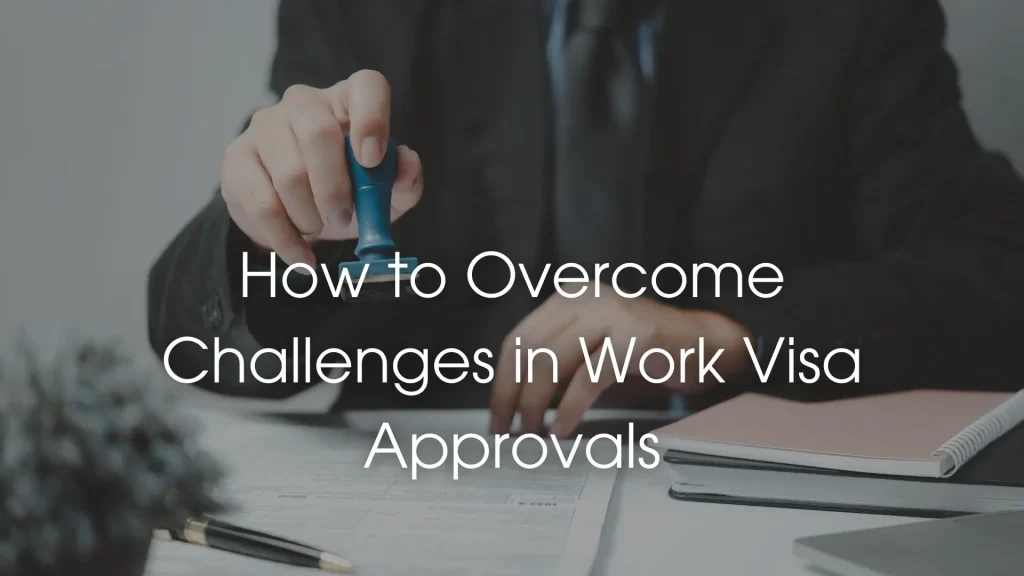 Work visa applications come with high hopes—and plenty of hurdles. Applicants face strict deadlines, complex requirements, and long wait times. One misstep can delay your approval or lead to a denial. You don’t have to let setbacks define your path. By overcoming work visa challenges—like documentation immigration note errors, sponsorship delays, or changing job roles—you give yourself a much better shot at success when you Understand the common challenges in the Employment-Based Visa Process—like employer sponsorship delays, changing job offers, or documentation errors—and learn how to approach them with clarity and preparation so you can confidently move forward.
Work visa applications come with high hopes—and plenty of hurdles. Applicants face strict deadlines, complex requirements, and long wait times. One misstep can delay your approval or lead to a denial. You don’t have to let setbacks define your path. By overcoming work visa challenges—like documentation immigration note errors, sponsorship delays, or changing job roles—you give yourself a much better shot at success when you Understand the common challenges in the Employment-Based Visa Process—like employer sponsorship delays, changing job offers, or documentation errors—and learn how to approach them with clarity and preparation so you can confidently move forward.
Common Work Visa Challenges and Overcoming Work Visa Challenges
Most applicants hit roadblocks they didn’t see coming. When you understand where people slip up, you can take action early and keep your application on track.
Incomplete Paperwork
Missing documents or inaccurate forms often trigger delays or denials. United States Citizenship and Immigration Services (USCIS) doesn’t guess—they need complete, clear, and properly filed information. Use a detailed document checklist for your work visa. Don’t rely on memory or guesswork. Check every form twice.
Employer Sponsorship Problems
Employers must meet strict sponsorship rules. They must follow wage guidelines, submit accurate job descriptions, and provide all required evidence. When they cut corners, it puts your visa at risk. Make sure your employer understands their responsibilities and follows every USCIS requirement. Also, remember to review your appointment guide to ensure you’re fully prepared for each step of the process.
USCIS Delays and RFEs: Overcoming Work Visa Challenges
Backlogs slow everything down. If USCIS flags your case, they’ll send a Request for Evidence (RFE). Respond quickly and thoroughly. Organize your documents clearly and submit strong proof. Don’t wait for deadlines to creep up—every day counts.
Interview Complications at the Consulate
Poor interview prep can cause real problems. Applicants who seem unsure or unprepared raise red flags. Review your application before the interview. Practice clear, confident answers. Prepare to explain your qualifications and job role in simple, direct language.
Proof of Qualifications
Some roles require advanced education, licensing, or years of experience. If you don’t provide strong proof, USCIS may reject your petition. Submit transcripts, credentials, past work records, and anything else that proves you meet the job requirements.
Tips to Strengthen a Work Visa Application
A strong application doesn’t just meet the minimum requirements—it anticipates what immigration officers look for and leaves no room for doubt. Start with the basics and build from there.
- Check and Recheck Everything—Don’t treat paperwork as a formality. Review each form, supporting document, and employer statement to ensure that every detail lines up and supports your case.
- Know the Process – Understand the immigration process steps before you begin. Each phase—filing, review, RFE response, interview—requires preparation. When you know what’s ahead, you make smarter decisions at every stage.
- Stay in Sync with Your Employer – You can’t afford misunderstandings. Work closely with your employer to confirm timelines, job duties, and sponsorship requirements. Keep them involved and informed from start to finish.
- Treat the Interview Like a Job You Need to Win – This isn’t just a formality. Visa officers look for consistency, preparation, and honesty. Walk into the consulate ready. Answer questions directly and confidently.
- Address Past Problems Head-On – Previous denials, overstays, or immigration violations don’t disqualify you, but they do need explanation. Take control of the narrative. Submit documents and personal statements that show you’ve resolved the issue and meet current eligibility.
Please read more about immigration verifications here: Immigrant workers may be subject to e-verification
Long-Term Strategies for Overcoming Visa Challenges
 You secure your future by thinking ahead. After your initial approval, each step forward depends on timing, accuracy, and ongoing attention.
You secure your future by thinking ahead. After your initial approval, each step forward depends on timing, accuracy, and ongoing attention.
Start Early on Renewals
Waiting too long can lead to renewal complications. Track your visa expiration date and begin the process months in advance. This gives you time to fix any issues that pop up.
Verify Your Status Regularly
Don’t assume everything’s fine. Check your immigration status and rights using official tools. Confirm your employer has the right records. Stay proactive, not reactive.
Work With an Attorney From Day One
Immigration law changes fast. A visa and immigration status attorney knows how to avoid costly mistakes. They’ll flag potential issues before they cause delays and help you stay on track from petition to approval.
Consider Alternative Visa Options
If one path blocks you, another may work better. L-1 visas, O-1 visas, and other employment-based options might fit your background more effectively. Don’t get stuck on one route if there’s a better option out there.
Take Control of Your Work Visa Journey
Visa issues can feel overwhelming, but you don’t have to stay stuck. When you take the right steps, you can turn delays into approvals and uncertainty into progress. The Law Office of William Jang, PLLC can help.
Suppose you face overwhelming immigration obstacles or want to avoid a work visa denial altogether. In that case, our team is here to help you understand your rights and take the first step toward securing the necessary benefits. Talk to a visa and immigration status attorney from our firm in Austin today. We’re ready to help you move forward with confidence. Reach out to us today.








